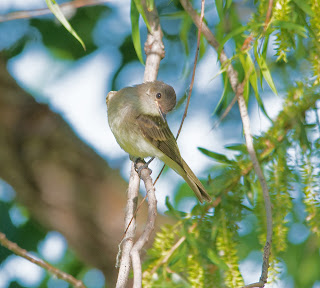060920 Bell's Vireo
061120 Eastern Phoebe
Eastern Phoebe 2
061520 Scissor-tailed Flycatcher
061820 Green Heron Adult
070220 Alligator Snapping Turtle
and Channel Catfish
Bell's Vireo has been increasingly active this year, as well as adding an extra bird to the fold, so to speak. This was a former youngster of Bell's 1, an original northeast breeder, no longer living. This current adult came to us courtesy of construction involving added electrical lines and the supports. While last year saw much removal of Bell's 1's territory, it simply moved to a new location apparently with either a juvenile in tow with hatched eggs south of the original location, of course temporarily out of service.
This new territory became Bell 1A's neighboring territory to Bell 1's south border. There is technically speaking, no territory north of that, which remains Bell 2's extended region, and it sometimes visits, but its main territory is north of Airport Rd. Bell 1 never visits this unoccupied area, which may become territory for another Bell's Vireo.
The above photo shows the male Bell 1A, who temporarily took a rare hiatus from his birthplace.
The above Eastern Phoebe, a sassy juvenile, tends to visit this extended area across from Kicker or Stillwater Designs where it hunts and could eventually nest.
The Scissor-tailed Flycatcher shown, especially for those readers not in Oklahoma, see a classic example of a neotropical migrant. This beautiful specimen is clearly a bird of the tropical forest with its bright coloring. Its tantalizing hues are actually a very subdued example of how it would look to another bird viewing it in the ultraviolet spectrum. As most of humanity is limited to the visible spectrum, people with a rare condition known as aphakia do possess natural ultraviolet vision. Birds usually have one extra cone that we lack, prohibiting normal vision from detecting the increased intensity of the ultraviolet spectrum.
This colorful adult Green Heron is obviously a member of the heron family, which also includes egrets. An egret is a heron, but a heron is not an egret. Ponder that thought...
The photo of the month is clearly this example of an alligator snapping turtle upon its prey, a channel catfish. As writer was on the way to Boomer Lake, an oddly moving channel cat caught my eye. It was eventually learned to be in motion due to the foraging turtle, who was consuming. However, it remains a mystery as to whether or not this turtle caused the demise of the catfish. It could well have been involved in cleanup detail, which is normal for these scavengers.






No comments:
Post a Comment